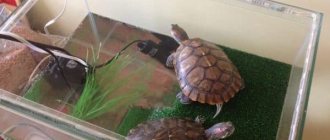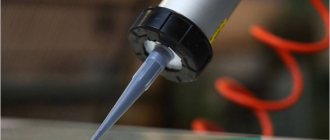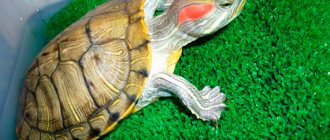Lighting is a very important factor in the life of any turtle, both land and aquatic.
There are many reptile lamps sold in pet stores today, but not all of them may be equally beneficial for your pets.
Moreover, the same lamp will demonstrate different efficiency under different conditions. When purchasing individual types, you will simply throw money away without getting the desired result.
So how do you choose the most useful lamp for your turtle and are they really necessary? Let's figure it out.
Features of keeping turtles
Under natural conditions, these creatures bask in the sun, receiving everything they need from their rays.
A sunbeam is a very rich spectrum in its components.
At home, you will have to recreate a similar microclimate for the full development and growth of the reptile. Therefore, at home they are placed in special aquariums or terrariums.
If your pet is a waterfowl, then you will have to make sure that the aquarium contains both water and land at the same time, in the form of a separate island. Moreover, the temperature on the island should not exceed certain degrees. Which ones will be discussed below.
At the same time, keep in mind that to grow a red-eared turtle, it should be a large aquarium, and not a small basin with palm trees and other crap. For normal growth they need a large space with all the conditions.
In general, keeping such pets entails significant costs for:
- aquarium with tray + reinforced cabinet for it
- powerful filter
- lighting and heating
- thermometers
- land or island
- decor
- cleaning accessories
So before buying a miniature and cute turtle in a pet store, be prepared for some significant expenses. And proper lighting is one of them.
Short description
Let's get to know the red-eared slider in a little more detail. The turtle got its “name” thanks to the bright red spots near the eyes on its head. Sometimes they can have an orange tint. Mostly turtles are small in size - from 3 to 10 centimeters, although they can also be quite large, giants for their species, reaching a diameter of up to 60 centimeters. The carapace is darker below, has an oval shape and is edged with yellow stripes.
The dorsal part is greenish, and as the turtle matures, it acquires an olive tint or yellowish-brown.
In the first few years of their life, turtles grow very actively; the diameter of the shell can grow up to 10 centimeters in a year. Then they grow much more slowly, adding only up to 2 centimeters every year.
UVB and UVA rays - what are they?
What should it be like? First, remember, you will need to purchase not one, but two types of lamps.
One of them will be an ultraviolet lamp with a UVB and UVA wave spectrum.
When choosing such light bulbs, the percentage of UVB content is important.
For relatively mature turtles (over 7 years old), it should be at least 5% (UVB 100 or 5.0). For small water and all land animals, choose 10% UVB (or UVB 150 - 10.0).
In this case, initially the paw can be raised slightly higher than the recommended value, and after a couple of months, it is gradually lowered, thereby manually adjusting the level of ultraviolet radiation.
For sick or pregnant turtles, UV lamps containing 10-12% UVB (UVB 200) are recommended.
It is the UVB indicator that plays the greatest role. However, UVA rays in such bulbs are usually about 30%.
What exactly are UV A and UV B rays and what role do they play? Type A sun rays are the ones that cause our skin to tan.
However, they do not pass through the layers of the skin and are harmless in moderate quantities. But type B rays penetrate the skin and, if too intense, can cause diseases, including cancer.
Such lamps (UVB) have a wave spectrum in the range of 290-320 nm. Anything below this range is harmful to both humans and animals.
And anything above 320 nm does not in any way help the formation of vitamin D3.
Roughly speaking:
- UVA - warmth
- UVB – vitamins
- UVC - harm
Any reptile that requires calcium gets it from vitamin D3 (cholecalceferol).
And it, in turn, is synthesized precisely when the animal spends a limited time either under natural sunlight (containing rays A and B in its spectrum), or under special lamps, which are original substitutes for such rays.
Why is ultraviolet needed?
An ultraviolet lamp for a turtle is one of the main sources of a healthy and fulfilling life. There is no way to do without it. In their natural environment, these animals receive ultraviolet radiation in sufficient quantities. Finding themselves in atypical conditions, in captivity, turtles experience a lack of sunlight and often get sick. Ultraviolet deficiency is especially difficult for pregnant females and young animals. Adults deprived of ultraviolet light also suffer from osteopenia and have clear signs of vitamin D deficiency.
The UV lamp for turtles perfectly imitates the sun's rays and promotes the absorption of calcium, which reptiles receive along with their food. Lack of ultraviolet radiation and calcium provokes many diseases, which are often fatal.
Is there an alternative to UV lamps?
Remember that no synthetic vitamin D or special food can fully replace this lighting. This primarily applies to land turtles.
Predators (red-eared animals), in natural habitats, receive an analogue of D3 through eaten animals.
Therefore, feeding sometimes saves them.
However, keeping aquatic turtles without UV for a long time is also not recommended. It's like putting you in a closet with one dim light bulb and stuffing you with all kinds of vitamins.
You will live, but you will acquire a bunch of diseases. The same applies to turtles.
Therefore, to the question “is it possible to do without ultraviolet radiation at all,” the answer is simple - no, it’s impossible.
On land turtles you will see the effects within a few weeks. For aquatic reptiles this will take a much longer period, but there will still be negative consequences.
Gradually, the turtle will develop rickets. The shell will become soft and brittle.
This also risks breaking limbs.
Placing an aquarium directly next to a window does not help, and cannot replace UV lamps. The fact is that sunlight passing through glass almost completely loses ultraviolet radiation, and you will not get any effect or benefit from such savings.
How long should it burn?
The duration of ultraviolet radiation largely depends on the age of the individual. For young turtles, the UV lamp is turned on for at least four hours a day.
If the lighting device is installed correctly and illuminates the entire area of the aquarium, then wherever the animal is, it will receive the necessary dose of ultraviolet radiation.
For turtles that have reached 2-3 years of age, it will be enough to receive radiation for a couple of hours. As the turtle ages, it is necessary to increase the power of the lighting device, since susceptibility decreases with age. For an adult to be healthy, it must sit directly under the lamp for at least an hour.
If your work schedule doesn't allow you to turn off the lights after four hours, don't worry. Some veterinarians believe that long-term exposure is even beneficial for reptiles. To improve the health of a sick turtle, you can leave the lamp on throughout the day. But excess ultraviolet radiation is still not absorbed.
Photoperiod is extremely important for the life of pets in captivity. It is best to set a clear schedule for turning the lights on and off. If you need to heat the terrarium at night, it is better to use infrared lamps that do not emit light.
The dangers of ultraviolet light bulbs
Is such ultraviolet radiation dangerous for humans and other animals? In the quantities emitted by UVB lamps, no, it is not dangerous. You won't even tan under these rays.
What to do if such a light bulb breaks?
Well, firstly, there is very little mercury vapor in them. So no one will get fatal poisoning.
Secondly, you will need to carry out basic disinfection measures. Wear gloves to remove fragments and white powder (luminophor). Next, ventilate the room for 1 hour.
It is not recommended to throw used lamps in the trash.
Hand them over to special points.
Service life - why so short?
The service life of all such UV lamps is limited and ranges from 3 months to 1 year (depending on the brand and manufacturer).
Please pay special attention that after this period, the lamp must be replaced, even if it has not burned out!
During this time, the ultraviolet spectrum of the light fades away and the light bulb turns into a useless backlight, losing all its UVB percentages.
This occurs due to the burnout of the fluorescent composition and the transition of the spectrum to a longer wavelength. Applies to both tubes and compacts.
And as mentioned above, anything above 320 nm no longer has any benefit and does not contribute to the production of vitamin D3.
That is, light bulbs do not become harmful, they become useless. They can be placed in an aquarium with fish or plants.
Also, the service life depends on power surges (tubes are more durable in this regard), the humidity level in the aquarium, heating temperature and other factors. Therefore, be aware that if it says 1 year on the package, this does not mean that the light bulb will work for exactly the time stated by the manufacturer.
User manual
The expiration date for each lamp is written on the packaging. Most often this is a year, but it can be shorter. After this, the device no longer meets the basic characteristics and is not useful. Therefore, it is very important to change it on time.
In addition, you should choose the location wisely. The lamp is placed above the turtle and should illuminate the entire aquarium. If we are talking about tubular devices, a lampshade is placed in the roof of the terrarium. Another option is to place the light directly above the open aquarium. After installation, you should make sure that the electrical wires do not hang down and are inaccessible to the turtle. The recommended distance to land is at least thirty-five centimeters.
If we are talking about adult turtles, then it is desirable for it to receive UV radiation of higher intensity for a short period of time. 2-3 hours a day
The age of the reptile matters. If we are talking about an adult individual, then it is desirable for it to receive UV radiation of higher intensity for a short period of time. 2-3 hours a day. Young, developing organisms require longer UV baths. At least 4 hours under radiation. To strengthen the reptile's body or you do not have the opportunity to turn off the device, it can burn until the evening. There will be no harm from such prolonged exposure - excess ultraviolet radiation will not be absorbed in the body.
Lamp with or without reflector?
When choosing lamps, it also matters which lamp you screw it into. The fact is that such UV lamps do not have any reflector and they scatter light in all directions.
Therefore, the most effective are lamps equipped with reflectors.
They have a shielded surface in the dome that concentrates the rays and directs them in a given direction. Here is a clear example of two different lamps with the same bulbs and the measured UVB level from them.
The efficiency of a model without a reflector is two times less!
Therefore, think carefully before installing UV bulbs in the body of a regular table lamp.
Do you want to lose such a share of useful radiation?
Place and height of installation of UV lamps in the aquarium
Where to place UV lamps in an aquarium? Compact ones should be located above the island, at a height of about 20-25cm from its level (with a power of about 25W).
Power 15W – 15-17cm from the surface.
In this case, there should be no protective glass between the turtle and the light bulb.
Otherwise, it will retain all the useful ultraviolet radiation.
Fluorescent tubes are attached to the lid and shine evenly over the entire aquarium, and not just on the island.
After installing the lamp at the calculated height, be sure to observe the behavior of the turtle for the first time. If she starts to show anxiety (she starts rubbing her eyes frequently, although this hasn’t happened before), then raise the light bulb a little higher!
Types of artificial lighting
Red-eared turtles are aquatic reptiles, which means they spend most of their lives on the water. They come to land to warm up and get a dose of ultraviolet radiation. To heat the aquaterrarium, special lamps are used, unlike land turtles, for heating which ordinary incandescent lamps are sufficient.
Mirror lamps
They are characterized by directional action, which significantly increases their efficiency. In addition, the light does not scatter to the sides, which indicates their practicality. Such lamps are more suitable for spot heating of a turtle's resting area.
Ceramic lamps
They are not a source of light, but are an excellent element of warming up the atmosphere inside the aquaterrarium.
Gas-discharge mercury lamps
They have excellent light and heat-emitting characteristics. In addition, they serve as a source of UV radiation.
Heating lamp in a terrarium
The second necessary lamp is a regular or mirror incandescent light bulb with a power of 40 to 60 W.
Since the turtle is a cold-blooded animal, all processes in its body depend on the ambient temperature. The incandescent light bulb creates the necessary warmth, like the summer sun.
It needs to be installed again above the island, and at such a height that the temperature below is 31-32 degrees.
Measure everything with a thermometer, adjusting the height of the suspension from 20 to 30 cm.
The height will depend primarily on the power of the light bulb. The optimal value is selected experimentally for each aquarium.
From the experience of other turtle lovers, we can give approximate calculations:
- 40W – suitable for small terrariums
Creates a temperature of about 29 degrees at the heating point.
- 50W – for aquariums with dimensions 50*35*30
Provides optimal temperature on the island of 30-33 degrees.
- 60W – for large aquariums 60*40*40
Warms up to a maximum of 35-40C.
The location of the suspension and the height can be adjusted with special sockets with wires on detachable plugs.
JBL has these in stock.
Glow time
How long should both reptile lamps be on? Both regular and UV should burn throughout the daylight hours from 10 to 12 hours. At night they are turned off.
To automate this process, it is advisable to purchase a timer socket or time relay.
You manually set the lighting start time (8.00 am) and shutdown time (20.00 pm) on them. Automation will do the rest for you.
In the morning you will be able to sleep longer, and in the evening you will not be distracted from watching your favorite TV series.
Light quality
The main characteristics of a lamp are its intensity and quality of light. The latter is determined by color temperature, measured in degrees on the Kelvin scale and determining the color of visible light. Concepts such as “cold” and “warm” light are also important. Quality is determined by the color rendering index and wave intensity distribution.
Since light is vital for terrarium animals, attention should be paid to its quantitative characteristics. Its high intensity is important so that the length of daylight hours corresponds to the photoperiod of the animal in its natural habitat. The light from the lamp should simulate the new circadian period (cyclical fluctuations in the intensity of biological processes) of the turtle, changing throughout the year.
Three aspects of radiation are important for keeping reptiles:
- ultraviolet;
- visible light (radiation in the visible part of the spectrum);
- infrared (thermal).
All described relationships between the quantitative and qualitative characteristics of light must be taken into account when choosing an ultraviolet lamp for a turtle. It is created with their own hands by a considerable number of exotic animal lovers. This is not difficult if you correctly understand the role of ultraviolet radiation, its sources in the life of reptiles, and also take into account all the necessary parameters.
Dangerous lamps for turtles
Now let's touch on the issue of lamps, which under no circumstances should be installed in an aquarium for turtles.
The following species are a dangerous source of light for them and contribute to the development of all kinds of diseases.
- UV lamps for drying gel polishes or lamps for manicure
- infrared medical heating lamp
- black UV lamp
- UV models for checking banknotes
- lamps from medical UV lamps
- lamps for plants
From these lamps, your turtle will receive radiation, which will lead to burns of the corneas of the eyes and blindness.
Therefore, be careful and install only lamps specifically designed for reptiles.
Why is it needed?
Calcium that is added to turtles' food is not absorbed properly into their bodies without exposure to UV light. Everyone knows that calcium is important for the strengthening and growth of bone tissue. If there is not enough calcium in the turtle's body, the shell becomes soft and may become deformed. Bones may become brittle and paw fractures will occur. The most urgent need for obtaining sufficient amounts of calcium is experienced by young animals and pregnant individuals.
Aquatic species, which include the red-eared turtle, are predators. They replenish vitamin D3 from the internal organs of small animals that they eat. In their case, the help of an ultraviolet lamp is not as important (although desirable) as for land breeds. Land turtles do not absorb vitamin D3 from food at all. The presence of ultraviolet radiation is vital for them.
Some people use tanning lamps (“Photon”) to enrich the turtle’s body with ultraviolet light. But this can only be done in five-minute sessions, because such lighting devices emit hard ultraviolet light.
UV+heat combination bulbs
In addition to the UV and incandescent lamps discussed, there are also combination lamps that simultaneously heat and produce ultraviolet light. The so-called UV + heating.
They cost significantly more. However, among them, most of the models, which, while emitting good heat, do not emit so much ultraviolet radiation. With separate lighting you can get much more of it.
At the same time, if a light bulb in separate lighting fails, you will need to replace one thing - an ultraviolet light or an incandescent lamp. In the combined version, you risk being left without light altogether.
The best option is to use UV lamps T8, T5 in the lid of the aquarium and ordinary lamps above the island. The tubes will provide uniform ultraviolet illumination over the entire area, and the regular tubes will comfortably warm up the turtle’s shell.
The decision must be balanced
Before you get a pet turtle, there are a few important things you need to seriously consider:
- Is it possible to care for a pet for a long time, because, as we know, reptiles can live quite a long time.
- Is it possible to purchase the necessary equipment for arranging a comfortable place for a turtle to live in a human home: an aquarium, an incandescent and UV lamp, and also, if the species is aquatic, then filters and purifiers.
- Provide your pet with adequate nutrition. For red-eared fish, this is boiled meat, shrimp, dried gammarus, and for land species - fresh greens all year round.











